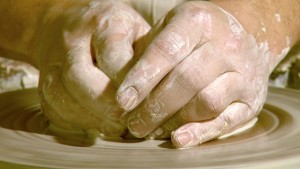Salt glazing is a unique process different from bisque pottery because it involves one single firing. These pots used to be essential for sanitary purposes in cooking, aiding in pickling and food storage.
The art and science of pottery requires skills and techniques acquired over generations of trial and error. The combination of the Owen family’s experiential knowledge of pottery and his university education - he graduated with a BFA in ceramics with honors in 1993 - make him a unique seasoned artist. Owen now employs additional scientific knowledge about how elements, chemical reactions, barometric pressure and temperature affect and improve his works of art.
“When you grow up in a family tradition, you learn things from family experience. People have the answers for you, but understanding what combinations of formulas work, what works based on temperature – If you don’t know how to recreate it, if you don’t know the science, you can’t reproduce it.
"Back when I was a teenager, we did things just because they worked. I asked a lot of questions: Why are we losing all these pots? What did we do wrong? Did we heat the kiln too fast? Being exposed to other potters, artists in a formal university setting, a lot of those things come out that help you realize what you did back then and why it didn’t work.”
Creating a piece of salt glazed pottery is a lengthy process. Before the glazing can begin, Owen must create the shape and pot itself.
“We place the clay on the wheel, center it, open it, form it into a bowl or cylinder adding water throughout the process until our piece is formed. After creating the shape and piece of pottery, we allow them to sit and dry for a couple of weeks."
After the pots are properly dried, the loading and firing process begins. The firing and heating of the kiln takes several days because the pots need to be warmed slowly to drive off moisture and water inside the core of the clay walls. If the pots are warmed too quickly, the moisture becomes steam and the pots start exploding inside the kiln.

The kiln is heated in stages, 200 degrees per hour, until it reaches 2300 degrees. Once the pottery is nearly molten, rock salt is thrown into the kiln. When salt is introduced into the kiln, it starts melting and becomes a glass, and then a vapor. This vapor is attracted to the silica in the clay and begins coating the surface of the pots, creating a unique orange peel texture. Test rings are used and dropped in water to see if the salt is building up properly and is creating the signature glassy appearance on the exterior of the pots.
The salt-glazing process takes seven days to complete, including two overnight shifts where Owen regulates the temperature of the kiln all night. Even though he's been firing his kiln for nearly 30 years, Owen still feels that there’s always room for improvement.
"No matter how many times you’ve done it, no matter how many times you’ve practiced doing it, I’m not doing surgery on a patient or somebody but I’m doing surgery on clay and I’m wanting that clay to be successful and be healthy when it comes out. So in a way, I’ve got to learn, I need to learn more about my materials to the extent that I can hopefully be able to make and determine the right decisions along the way that can solve some of these problems.”
Additional Links:
Seagrove Area Potters Association
Celebration of Seagrove Potters

